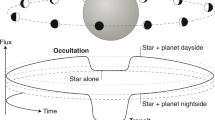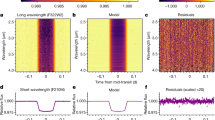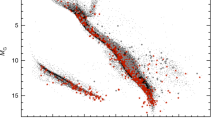Abstract
Exoplanets are distant worlds that orbit stars other than our Sun. More than 370 such planets are known, and a growing fraction of them are discovered because they transit their star as seen from Earth. The special transit geometry enables us to measure masses and radii for dozens of planets, and we have identified gases in the atmospheres of several giant ones. Within the next decade, we expect to find and study a ‘habitable’ rocky planet transiting a cool red dwarf star close to our Sun. Eventually, we will be able to image the light from an Earth-like world orbiting a nearby solar-type star.
This is a preview of subscription content, access via your institution
Access options
Subscribe to this journal
Receive 51 print issues and online access
$199.00 per year
only $3.90 per issue
Buy this article
- Purchase on Springer Link
- Instant access to full article PDF
Prices may be subject to local taxes which are calculated during checkout





Similar content being viewed by others
References
Mayor, M. & Queloz, D. A. Jupiter-mass companion to a solar-type star. Nature 368, 355–359 (1995)The first detection of a planet orbiting a solar-type star.
Marcy, G. et al. Exoplanet properties from Lick, Keck and AAT. Phys. Scripta T 130, 014001 (2008)
Trauger, J. T. & Traub, W. A. A laboratory demonstration of the capability to image an Earth-like extrasolar planet. Nature 446, 771–773 (2007)
Cash, W. Detection of Earth-like planets around nearby stars using a petal-shaped occulter. Nature 442, 51–53 (2006)Proposes a promising and practical method for imaging Earth-analogue exoplanets.
Kalas, P. et al. Optical images of an extrasolar planet 25 light-years from Earth. Science 322, 1345–1347 (2008)
Marois, C. et al. Direct imaging of multiple planets orbiting the star HR 8799. Science 322, 1348–1352 (2008)
Marley, M. S., Fortney, J. J., Hubickyj, O., Bodenheimer, P. & Lissauer, J. J. On the luminosity of young Jupiters. Astrophys. J. 655, 541–549 (2007)
Chiang, E., Kite, E., Kalas, P., Graham, J. R. & Clampin, M. Fomalhaut's debris disk and planet: constraining the mass of Fomalhaut b from disk morphology. Astrophys. J. 693, 734–749 (2009)
Charbonneau, D., Brown, T. M., Burrows, A. & Laughlin, G. in Protostars and Planets V (eds Reipurth, B., Jewitt, D. & Keil, K.) 701–716 (Univ. Arizona Press, 2007)
Charbonneau, D., Brown, T. M., Latham, D. & Mayor, M. Detection of planetary transits across a Sun-like star. Astrophys. J. 529, L45–L48 (2000)Reports the first full transit of a planet across a Sun-like star.
Henry, G. W., Marcy, G. W., Butler, R. P. & Vogt, S. S. A transiting “51-Peg-like” planet. Astrophys. J. 529, L41–L44 (2000)
Guillot, T. & Showman, A. P. Evolution of “51-Pegasus-b-like” planets. Astron. Astrophys. 385, 156–165 (2002)
Miller, N., Fortney, J. J. & Jackson, B. Inflating and deflating hot Jupiters: coupled tidal and thermal evolution of known transiting planets. Astrophys. J. (submitted); preprint at 〈http://arxiv.org/abs/0907.1268〉 (2009)
Deming, D., Seager, S., Richardson, L. J. & Harrington, J. Infrared radiation from an extrasolar planet. Nature 434, 740–743 (2005)This paper and ref. 24 simultaneously report the first detection of light from an exoplanet.
Knutson, H. A., Charbonneau, D., Burrows, A., O'Donovan, F. T. & Mandushev, G. Detection of a temperature inversion in the broadband infrared emission spectrum of TrES-4, 2009. Astrophys. J. 691, 866–874 (2009)
Chabrier, G. & Baraffe, I. Heat transport in giant (exo)planets: a new perspective. Astrophys. J. 661, L81–L84 (2007)
Burke, C. J. et al. XO-5b: a transiting Jupiter-sized planet with a 4-day period. Astrophys. J. 686, 1331–1340 (2008)
Bakos, G. A. et al. HAT-P-10b: a light and moderately hot Jupiter transiting a K-dwarf. Astrophys. J. 696, 1950–1955 (2009)
West, R. G. et al. The low density transiting exoplanet WASP-15b. Astron. J. 137, 4834–4836 (2009)
Gillon, M. et al. Detection of transits of the nearby hot Neptune GJ436b. Astron. Astrophys. 472, L13–L16 (2007)GJ436b is the first transiting planet significantly smaller than Jupiter.
Bakos, G. A. et al. HAT-P-11b: a super-Neptune planet transiting a bright K star in the Kepler field. Astrophys. J. (in the press); preprint at 〈http://arxiv.org/abs/0901.0282〉 (2009)
Queloz, D. et al. The CoRoT-7 planetary system: two orbiting super-Earths. Astron. Astrophys. (in the press)CoRoT-7b is the first transiting super-Earth exoplanet.
Borucki, W. et al. in Transiting Planets (eds Pont, F., Sasselov, D. & Holman, M. J.) 289–299 (IAU Symp. 253, Cambridge Univ. Press, 2009)
Charbonneau, D. et al. Detection of thermal emission from an extrasolar planet. Astrophys. J. 626, 523–529 (2005)This paper and ref. 14 simultaneously report the first detection of light from an exoplanet.
Deming, D., Harrington, J., Seager, S. & Richardson, L. J. Strong infrared emission from the extrasolar planet HD 189733b. Astrophys. J. 644, 560–564 (2006)
Charbonneau, D. et al. The broadband infrared emission spectrum of the exoplanet HD 189733b. Astrophys. J. 686, 1341–1348 (2008)
Knutson, H. A. et al. A map of the day-night contrast of the extrasolar planet HD189733b. Nature 447, 183–186 (2007)A long series of Spitzer observations enabled a longitudinal temperature map of an exoplanet for the first time.
Harrington, J., Luszcz, S., Seager, S., Deming, D. & Richardson, L. J. The hottest planet. Nature 447, 691–693 (2007)
Knutson, H. A., Charbonneau, D., Allen, L. E., Burrows, A. & Megeath, S. T. The 3.6–8.0 micron broadband emission spectrum of HD 209458b: evidence for an atmospheric temperature inversion. Astrophys. J. 673, 526–531 (2008)Many giant exoplanets have temperature inversions in their atmospheres, and HD209458b is the archetype for this important phenomenon.
Machalek, P. et al. Thermal emission of exoplanet XO-1b. Astrophys. J. 684, 1427–1432 (2008)
Machalek, P., McCullough, P. R., Burrows, A., Burke, C. J. & Hora, J. L. Detection of thermal emission of XO-2b: evidence for a weak temperature inversion. Astrophys. J. 701, 514–520 (2009)
Seager, S. & Sasselov, D. D. Theoretical transmission spectra during extrasolar giant planet transits. Astrophys. J. 537, 916–921 (2000)
Sudarsky, D., Burrows, A. & Hubeny, I. Theoretical spectra and atmospheres of extrasolar giant planets. Astrophys. J. 588, 1121–1148 (2003)
Seager, S. et al. On the dayside thermal emission of hot Jupiters. Astrophys. J. 632, 1122–1131 (2005)
Rowe, J. F. et al. The very low albedo of an extrasolar planet: MOST space-based photometry of HD 209458. Astrophys. J. 689, 1345–1353 (2008)
Alonso, R. et al. The secondary eclipse of the transiting exoplanet CoRoT-2b. Astron. Astrophys. 501, L23–L26 (2009)
Marley, M. S., Gelino, C., Stephens, D., Lunine, J. I. & Freedman, R. Reflected spectra and albedos of extrasolar giant planets. I. Clear and cloudy atmospheres. Astrophys. J. 513, 879–893 (1999)
Seager, S., Whitney, B. A. & Sasselov, D. D. Photometric light curves and polarization of close-in extrasolar giant planets. Astrophys. J. 540, 504–520 (2000)
Richardson, L. J., Deming, D., Horning, K., Seager, S. & Harrington, J. A spectrum of an extrasolar planet. Nature 445, 892–895 (2007)
Grillmair, C. J. et al. A Spitzer spectrum of the exoplanet HD 189733b. Astrophys. J. 658, L115–L118 (2007)
Grillmair, C. J. et al. Strong water absorption in the dayside emission spectrum of the planet HD189733b. Nature 456, 767–769 (2008)Reports the unequivocal detection of water vapour in the spectrum of an exoplanet.
Swain, M. R., Vasisht, G. & Tinetti, G. The presence of methane in the atmosphere of an extrasolar planet. Nature 452, 329–331 (2008)
Swain, M. R. et al. Molecular signatures in the near-infrared dayside spectrum of HD 189733b. Astrophys. J. 690, L114–L117 (2009)
Vidal-Madjar, A. et al. An extended upper atmosphere around the extrasolar planet HD209458b. Nature 422, 143–146 (2003)
Charbonneau, D., Brown, T. M., Noyes, R. W. & Gilliland, R. L. Detection of an extrasolar planet atmosphere. Astrophys. J. 568, 377–384 (2002)
Harrington, J. et al. The phase-dependent infrared brightness of the extrasolar planet upsilon Andromedae b. Science 314, 623–626 (2006)
Cowan, N. B., Agol, E. & Charbonneau, D. Hot nights on extrasolar planets: mid-infrared phase variations of hot Jupiters. Mon. Not. R. Astron. Soc. 379, 641–646 (2007)
Knutson, H. A. et al. The 8-micron phase variation of the hot Saturn HD 149026b. Astrophys. J. 703, 769–784 (2009)
Showman, A. P., Menou, K. & Cho, J. Y.-K. in Extreme Solar Systems (eds Fischer, D., Rasio, F. A., Thorsett, S. E. & Wolszczan, A.) 419 (ASP Conf. Ser. Vol. 398, Astronomical Society of the Pacific, 2008)
Menou, K. & Rauscher, E. Atmospheric circulation of hot Jupiters: a shallow three-dimensional model. Astrophys. J. 700, 887–897 (2009)
Hubeny, I., Burrows, A. & Sudarsky, D. A possible bifurcation in atmospheres of strongly irradiated stars and planets. Astrophys. J. 594, 1011–1018 (2003)
Fortney, J. J., Lodders, K., Marley, M. S. & Freedman, R. S. A unified theory for the atmospheres of the hot and very hot Jupiters: two classes of irradiated atmospheres. Astrophys. J. 678, 1419–1435 (2008)
Zahnle, K., Marley, M. S., Freedman, R. S., Lodders, K. & Fortney, J. J. Atmospheric sulphur photochemistry on hot Jupiters. Astrophys. J. 701, L20–L24 (2009)
Laughlin, G. et al. Rapid heating of the atmosphere of an extrasolar planet. Nature 457, 562–564 (2009)
Winn, J. et al. HAT-P-7: a retrograde or polar orbit, and a third body. Astrophys. J. 703, L99–L103 (2009)
Fabrycky, D. & Tremaine, S. Shrinking binary and planetary orbits by Kozai cycles with tidal friction. Astrophys. J. 669, 1298–1315 (2007)
Yu, Q. & Tremaine, S. Resonant capture by inward-migrating planets. Astron. J. 121, 1736–1740 (2001)
Lopez-Morales, M. & Seager, S. Thermal emission from transiting very hot Jupiters: prospects for ground-based detection at optical wavelengths. Astrophys. J. 667, L191–L194 (2007)
Snellen, I. A. G., de Mooij, E. J. W. & Albrecht, S. The changing phases of extrasolar planet CoRoT-1b. Nature 459, 543–545 (2009)
Borucki, W. J. et al. Kepler's optical phase curve of the exoplanet HAT-P-7b. Science 325, 709 (2009)Kepler's spectacular photometric precision means that transiting Earth-analogue exoplanets are now within reach.
Ballard, S. et al. A search for additional planets in the NASA EPOXI observations of GJ 436. Astrophys. J. (submitted); preprint at 〈http://arxiv.org/abs/0909.2875〉 (2009)
de Mooij, E. J. W. & Snellen, I. A. G. Ground-based K-band detection of thermal emission from the exoplanet TrES-3b. Astron. Astrophys. 493, L35–L38 (2009)
Gillon, M. et al. VLT transit and occultation photometry for the bloated planet CoRoT-1b. Astron. Astrophys. (in the press)
Froning, C. & Greene, J. C. The cosmic origins spectrograph: capabilities and pre-launch performance. Astrophys. Space Sci. 320, 181–185 (2009)
Barnes, J. R. A search for molecules in the atmosphere of HD189733b. Mon. Not. R. Astron. Soc. (in the press); preprint at 〈http://arxiv.org/abs/0909.2510〉 (2009)
Seager, S., Kuchner, M., Hier-Majumder, C. A. & Militzer, B. Mass-radius relationship for solid exoplanets. Astrophys. J. 669, 1279–1297 (2007)Predicts the global properties of super-Earth exoplanets.
Mayor, M. et al. The HARPS search for southern extrasolar planets XIII. A planetary system with three super-Earths. Astron. Astrophys. 493, 639–644 (2009)Concludes that super-Earth exoplanets are common around stars similar to our Sun.
Gould, A. et al. Microlens OGLE-2005-BLG-169 implies that cool Neptune-like planets are common. Astrophys. J. 644, L37–L40 (2006)
Nutzman, P. & Charbonneau, D. Design considerations for a ground-based transit search for habitable planets orbiting M-dwarfs. Publ. Astron. Soc. Pacif. 120, 317–327 (2007)
Deming, D. et al. Discovery and characterization of transiting superEarths using an all-sky transit survey, and follow-up by the James Webb Space Telescope. Publ. Astron. Soc. Pacif. 121, 952–967 (2009)
Miller-Ricci, E., Seager, S. & Sasselov, D. The atmospheric signatures of super-Earths: how to distinguish between hydrogen-rich and hydrogen-poor atmospheres. Astrophys. J. 690, 1056–1067 (2009)
Tarter, J. C. et al. A reappraisal of the habitability of planets around M-dwarf stars. Astrobiology 7, 30–65 (2007)
Spergel, D. N. et al. THEIA: Telescope for Habitable Exoplanets and Interstellar/Intergalactic Astronomy. Bull. Am. Astron. Soc. 213, abstr. 458.04 (2009)
Fortney, J. J., Marley, M. S. & Barnes, J. W. Planetary radii across five orders of magnitude in mass and stellar insolation: application to transits. Astrophys. J. 659, 1661–1672 (2007)
Burrows, A., Budaj, J. & Hubeny, I. Theoretical spectra and light curves of close-in extrasolar planets and comparison with data. Astrophys. J. 678, 1436–1457 (2008)
Acknowledgements
This work is based in part on observations made with the Spitzer Space Telescope, which is operated by the Jet Propulsion Laboratory, California Institute of Technology, under a contract with NASA. Support for this work was provided directly by NASA, and by NASA through an award issued by JPL/Caltech.
Author Contributions Both authors contributed equally to this work.
Author information
Authors and Affiliations
Corresponding author
Rights and permissions
About this article
Cite this article
Deming, D., Seager, S. Light and shadow from distant worlds. Nature 462, 301–306 (2009). https://doi.org/10.1038/nature08556
Issue Date:
DOI: https://doi.org/10.1038/nature08556
This article is cited by
-
Atmospheric Dynamics of Hot Giant Planets and Brown Dwarfs
Space Science Reviews (2020)
-
The four hundred years of planetary science since Galileo and Kepler
Nature (2010)
Comments
By submitting a comment you agree to abide by our Terms and Community Guidelines. If you find something abusive or that does not comply with our terms or guidelines please flag it as inappropriate.



